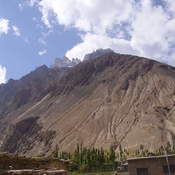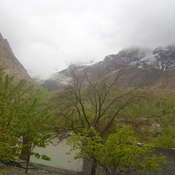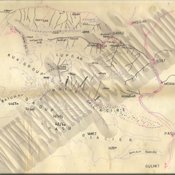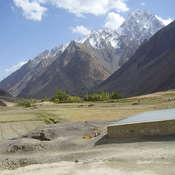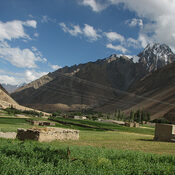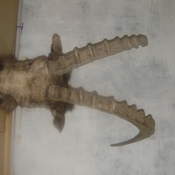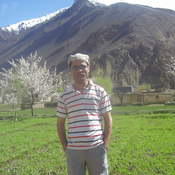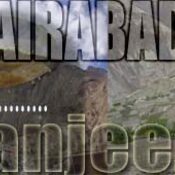<<<<<<>>>>>>>>
THE VILLAGE:
Raminji is a small village of Hunza Sub-Division, Gojal, District Gilgit. It is located at an altitude of 3110 meters. 25 Km away from the Karakorm Highway (KKH). The village is connected to the nearest town Sost through an up-raved Kachha jeep able road. According to the local council census report, the village comprises 29 households with a total population some 400 plus.
VILLAGE HISTORY:
Raminji village for the first time was established in 1914 during the regime of Mir Nazim Khan, then state king of Hunza. A channel was constructed under the direct supervision of Mir Nazim Khan, using only local available equipment. The people from Mayoon to Chipurson equally participated in digging out the most troublesome channel along aa very hard rock. Mir Nazim Khan was benevolent to his people. He would distribute all the levies among the workers which he received from other villages of chiporson in the form of wheat, butter and animals. He would also arrange local dance parties in the evening to entertain the workers. Seven years after when construction of Raminji water channel in 1921 was completed, Mir Nazim Khan sent the following people belonging to different clans to get settled down in this village.
|
S.NO |
NAME |
CLAN (ROME) |
|
1. |
Mohsin (Mosing) |
Khurokuch |
|
2 |
Zamin Shah |
Datosing (Dikhankuch) |
|
3 |
Bulbul |
Do |
|
4 |
Nabi |
Do |
|
5 |
Tahir Aman |
Do |
|
6 |
Nadilo |
Do |
|
7 |
Dinar Shah |
Do |
|
8 |
Bahar Shah |
Datosing |
|
9 |
Chito Akbar Sing |
Do |
|
10 |
Ganji Ali |
Diramiting |
|
11 |
Nadir Shah |
Do |
|
12 |
Sagi |
Do |
|
13 |
Qalander Shah |
Barataling |
|
14 |
Mehdi Shah |
Do |
Zamin Shah and Sagi came from Haiderabad Hunza, Bahar Shah from Garelt Hunza and rest of the eleven people came from Karimabad Hunza. Since this village was located in the most difficult and remote part of the state therefore, people were not willing to migrate. According to the informants these people were forcefully sent to this village. Initially, the village was named as Khairabad because the village was declared as tax free zone.
These twelve people faced enormous difficulties and worked very hard for their survival. Till 1928, people lived here as seasonal migrants. They used to migrate to Hunza in winters and come back in summers. In 1928, six people fell victims of a dreadful landslide which took their lives away while they were working under a very dangerouls landslide area of water channel. Among those victims were; Mohsin, Nadir Amanl Ganj Ali, Zamin Shah Nadilo and Mehdi.
That particular accident created a great disappointment among the existing people. Widows and orphans were so shocked and frustrated hence, two of the widows could not coup with the grief and left for Hunza. The remaining victims went to Nazim Khan to complain about their plight and requested him to send them back to Hunza. But Nazim Khan was also clever. He never wanted to leave this village undeveloped. Therefore, again he used his dictatorship and transferred six more people from Hunza as permanent settlers to this village. He also donated his own land known as Iljum Basi (The back yard) to these people. He paid special attention to widows and orphans just to make sure that they would not leave the area. The following were the second phase migrants from Karimabad Hunza to Raminji.
|
S.NO |
NAME |
CLAN (ROME) |
|
1. |
Mohabbat Shah |
Diramiting |
|
2 |
Hazar Shah |
Barataling |
|
3 |
Qinnat Shah |
Khurokutch |
|
4 |
Ghulam Shah |
Do |
|
5 |
Niamat Shah |
Do |
|
6 |
Wafi |
Wakhi |
|
7 |
Shukoor Ali |
Ganj Ali’s Brother |
|
8 |
Inayat Shah |
Mehdi’s Brother |
|
9 |
Reqmat Shah |
Nadilo’s relative |
All above people were sent from Karimabad Hunza except one who was from Gojal. As Ganj Ali and Mehdi had no children therefore their brothers inherited the land and property.
Time Line History:
1940-41: Jamat Khana construction started and completed in 1942.
1942: Primary education started at Khalifa Asmatullah’s home. He rendered his services as a teacher on a monthly meager salary of Rs. 5/- from Imamat Fund.
1945: The community constructed “ Matuming Galing” (Black stairs) irrigation channel.
1950: Another irrigation channel was constructed in “Harkish Nala”. The barren land under the channel was developed for growing agricultural crops. After AKRSP’s intervention they started to develop surrounding areas of the village. Due to inaccessibility this development area of “Harkish Nala” was left as such.
1954: The community constructed another irrigation channel to “Deyore” . after three years, the channel was again destroyed du to excess water in the channel. As a result of that a bridge linking their pasture with the village, and the irrigation channel of the village down “Deyore” was also damaged. Mir Jamal Khan sent some other people from Khyber, Misgar, Moorkhun, Sost and Khudabad to repair the broken channel.
1959: A week long heavy rains completely damaged the main irrigation channel. Mohammad Tayum “Numberdar” (Head of the village) informed the Mir about the damage and requested him for help. On his request Mir sent some people. During repair work, a piece of rock slided down and two young men, Faqir Shan S/o Nadir Shan, Ayub Shan S/o Inayat Shan died on the spot.
1967-68: New Jamat Khana building was constructed by the community.
1970: another soil erosion completely destroyed many agricultural fields. The channel to “Khai” area down the village was also damaged.
1971: a very serious dispute started with Yarzrish over a barren land. Both opponents went up to civil court. Finally the dispute was settled through Ismaili Regional Council.
1972: Mr. Aziz Ullah convinced the community to construct the school building. So the community constructed a single school building on self-help basis. Female education started in the same year.
1974-79: The community constructed another portion of school. LB & RD funded Rs. 7,000/- (Rupees Seven thousand only) for construction.
1979: Started construction of government funded jeep-able road from Sost to Ziarat. It was completed in 1982-83.
1983: VO (Village Organization) was formed.
1984: Link road was completed as a PPI. Aslo WO (Women’s Organization) was formed.
1985: Link road was damaged due to heavy soil erosion.
1986: Land Development project was initiated. A loan of Rs. 54,000/= (Rupees fifty four thousand only) for five years without service charges was provided. As an impact of this project, the village got sufficient water and fruit and forest plants were planted.
1987: Diamond Jubilee School building constructed with the help of Aga Khan Housing Board.
1990: Another irrigatin channel to Sadiqabad (Shupurang) was constructed. The community also planted some 12,000 cuttings. AKRSP paid a remuneration of Rs. 1/- per plant cutting.
Living standards started improving. Housing conditions, food habits and dressing patterns of the people changed.
1992: Heavy rains damaged cattle sheds, old school building and main irrigation channel.
1993: Received Prime Minister Fund ( Rs. 62,000/-) for rehabilitation of damaged community resources.
1999: Another Land Development project was provided by AKRSP. A total of 20,000/- plants were planted.
Drinking water was one of core issues of the village. Fresco weather does not allow arrigation channel to pass drinking water through to the village, so people used to get drinking water from river passing along with the Chupurson Road.
1998-1999 Three (3) water tanks were built with support of an NGO and locals for storage of drinking water to be use in winter season under tough weather conditions.
Under Construction

